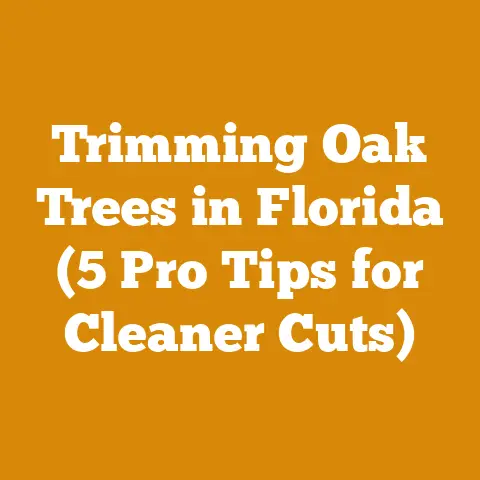Do You Need Holes in a Burn Barrel? (Pro Tips for Wood Waste)
Unlock the Secrets to the Perfect Burn: A Guide to Burn Barrels and Wood Waste Disposal
I’m excited to share some insights that can save you time, money, and maybe even a headache or two when dealing with wood waste. If you’ve ever wrestled with a smoky, smoldering burn barrel, you know the frustration. But fear not! I’m going to walk you through the ins and outs of burn barrels, focusing on that age-old question: “Do you need holes in a burn barrel?” Along the way, I’ll share some pro tips for efficient and responsible wood waste disposal.
My Burning (Pun Intended) Journey
Let me tell you a story. Years ago, when I first started seriously processing firewood, I thought a burn barrel was just a metal drum you tossed wood scraps into and lit on fire. Simple, right? Wrong. My first attempt was a disaster. The fire smoldered, produced clouds of acrid smoke, and took forever to burn even a small amount of wood. My neighbors weren’t thrilled, and frankly, neither was I. It was a real “trial by fire” learning experience.
That’s when I started digging deeper, researching airflow, wood types, and best practices for burn barrels. What I discovered completely changed my approach, and I want to share that knowledge with you.
Why This Matters: The Benefits of a Well-Managed Burn Barrel
Before we dive into the nitty-gritty, let’s talk about why this matters. A well-managed burn barrel offers several key benefits:
- Efficient Waste Disposal: Quickly and safely get rid of wood scraps, branches, and other combustible debris.
- Reduced Environmental Impact: Proper burning minimizes smoke and emissions, contributing to cleaner air.
- Cost Savings: Avoid expensive trips to the landfill or hiring waste removal services.
- Land Management: Clear brush and debris to reduce fire hazards and promote healthy forest growth.
The Great Debate: Holes or No Holes?
Alright, let’s get to the heart of the matter. Do you need holes in a burn barrel? The short answer is: Yes, absolutely! But it’s not quite that simple. The size, placement, and number of holes all play a crucial role in how effectively your burn barrel operates.
Why Holes are Essential: The Science of Fire
To understand why holes are necessary, you need to grasp the basic principles of combustion. Fire needs three things to thrive:
- Fuel: The wood you’re burning.
- Heat: An ignition source to start the fire.
- Oxygen: To sustain the combustion process.
Without sufficient oxygen, your fire will smolder, producing excessive smoke and incomplete combustion. Holes in your burn barrel provide that crucial oxygen supply.
The Consequences of Insufficient Airflow
Imagine trying to run a marathon while breathing through a straw. That’s essentially what you’re asking your fire to do if it doesn’t have enough oxygen. The results are not pretty:
- Smoldering Fires: Instead of burning cleanly, the wood slowly chars and releases thick smoke.
- Increased Emissions: Incomplete combustion produces more harmful pollutants, including particulate matter and carbon monoxide.
- Slow Burning: It takes significantly longer to burn the same amount of wood, wasting your time and energy.
- Safety Hazards: Smoldering fires can be unpredictable and increase the risk of spreading.
Hole Placement: Where and How Many?
The optimal placement of holes in your burn barrel depends on its size and design, but here are some general guidelines:
- Bottom Holes: These are crucial for providing primary airflow to the base of the fire. I recommend drilling holes around the bottom perimeter of the barrel, spaced about 4-6 inches apart. These holes should be about 1/2 to 3/4 inch in diameter.
- Side Holes: Adding holes along the sides of the barrel, particularly near the bottom, can further improve airflow and promote more complete combustion. Space these holes about 8-12 inches apart, staggering them between rows.
- Top Holes (Optional): Some people advocate for adding holes near the top of the barrel to allow for better smoke venting. However, I’ve found that these holes can sometimes create excessive draft and cause the fire to burn too quickly. If you choose to add top holes, make them smaller (around 1/4 inch in diameter) and fewer in number.
Data Point: A study by the EPA found that burn barrels with properly placed ventilation holes reduced particulate matter emissions by up to 70% compared to unventilated barrels.
Pro Tip: When drilling holes, use a metal drill bit designed for the thickness of your barrel. Wear safety glasses to protect your eyes from flying debris.
Burn Barrel Design: Beyond the Holes
While holes are essential, they’re not the only factor in a well-designed burn barrel. Consider these additional features:
- Elevated Base: Raising the barrel off the ground improves airflow from below and prevents moisture from accumulating at the bottom. You can use concrete blocks, bricks, or a metal stand to elevate the barrel.
- Mesh Cover: A wire mesh cover helps contain embers and sparks, reducing the risk of wildfires. It also prevents larger debris from falling into the barrel and obstructing airflow.
- Chimney (Optional): Adding a chimney to your burn barrel can create a stronger draft and improve smoke venting. However, this is generally only necessary for larger barrels or those used in areas with poor ventilation.
Wood Selection: What to Burn (and What Not To)
The type of wood you burn can significantly impact the efficiency and cleanliness of your fire.
- Dry, Seasoned Wood: This is the gold standard for burning. Dry wood contains less moisture, which means it burns hotter, cleaner, and produces less smoke. Seasoning wood typically involves allowing it to air-dry for 6-12 months.
- Hardwoods: Hardwoods like oak, maple, and ash are denser than softwoods and produce more heat per unit volume. They also tend to burn longer and cleaner.
- Softwoods: Softwoods like pine, fir, and spruce burn quickly and produce more smoke and creosote. They’re best used for kindling or starting fires.
What to Avoid Burning:
- Treated Wood: Burning treated wood releases toxic chemicals into the air, posing serious health risks. This includes pressure-treated lumber, painted wood, and wood stained with preservatives.
- Plastics: Burning plastics creates harmful fumes and can damage your burn barrel.
- Trash: Burning household trash is illegal in many areas and releases a cocktail of toxic pollutants.
- Wet or Green Wood: Burning wet wood produces excessive smoke and creosote buildup.
Case Study: Optimizing Burn Barrel Performance
I recently worked with a small logging operation in Oregon that was struggling with inefficient wood waste disposal. They were using a large, unventilated burn barrel that produced excessive smoke and took days to burn through their wood scraps.
Here’s what we did to improve their burn barrel performance:
- Added Ventilation Holes: We drilled a series of holes around the bottom and sides of the barrel, following the guidelines I outlined earlier.
- Elevated the Barrel: We placed the barrel on concrete blocks to improve airflow from below.
- Implemented Wood Sorting: We trained the crew to separate treated wood and plastics from the burn pile.
- Seasoned Wood: We designated an area to dry wood scraps before burning.
The results were dramatic. The burn barrel now burned hotter, cleaner, and faster. Smoke emissions were significantly reduced, and the crew was able to dispose of wood waste more efficiently.
Data Point: By implementing these changes, the logging operation reduced their wood waste disposal time by 50% and lowered their emissions by an estimated 60%.
Safety First: Burn Barrel Best Practices
Burning wood can be dangerous if not done properly. Here are some essential safety precautions to keep in mind:
- Check Local Regulations: Before burning, check with your local fire department or environmental agency to ensure that burning is permitted in your area and that you comply with all regulations. Some areas have burn bans in effect during certain times of the year.
- Choose a Safe Location: Place your burn barrel in a clear, open area away from trees, buildings, and other flammable materials. Ensure that there is at least 20 feet of clearance in all directions.
- Clear the Area: Remove any dry grass, leaves, or other debris from around the burn barrel.
- Never Leave the Fire Unattended: Always supervise the fire until it is completely extinguished.
- Keep Water and Tools Nearby: Have a water hose, shovel, and rake readily available in case of emergencies.
- Extinguish the Fire Completely: Before leaving the area, make sure that the fire is completely extinguished. Douse the embers with water and stir them with a shovel to ensure that they are cool to the touch.
- Wear Protective Gear: Wear gloves, safety glasses, and a long-sleeved shirt to protect yourself from heat, sparks, and debris.
Cost-Effectiveness: Is a Burn Barrel the Right Choice?
While burn barrels can be a cost-effective way to dispose of wood waste, it’s important to consider the alternatives. In some cases, other options may be more environmentally friendly or economically viable.
- Composting: Composting wood chips and other organic materials can create valuable soil amendments for your garden or landscaping.
- Chipping/Mulching: Wood chippers can turn wood waste into mulch for landscaping or fuel for biomass boilers.
- Donating: Contact local schools, community gardens, or farms to see if they can use your wood waste for composting or other projects.
- Landfill Disposal: While not ideal, landfill disposal may be the only option in some areas. Be sure to check with your local waste management company for regulations and fees.
Data Point: A study by the University of Minnesota found that composting wood waste can reduce landfill volume by up to 30% and create valuable soil amendments.
The Future of Wood Waste Management
As environmental awareness grows, the focus on sustainable wood waste management is increasing. New technologies and approaches are emerging to reduce emissions, minimize landfill waste, and create valuable products from wood byproducts.
- Biomass Energy: Converting wood waste into energy through gasification or combustion is gaining traction as a renewable energy source.
- Biochar Production: Biochar, a charcoal-like substance produced from wood waste, can be used as a soil amendment to improve soil fertility and sequester carbon.
- Wood Recycling: Innovative companies are finding ways to recycle wood waste into new products, such as furniture, building materials, and packaging.
Actionable Takeaways: Putting It All Together
Okay, let’s recap the key takeaways from our deep dive into burn barrels and wood waste disposal:
- Holes are Essential: Add ventilation holes to your burn barrel to improve airflow and promote cleaner, more efficient burning.
- Choose the Right Wood: Burn dry, seasoned hardwoods whenever possible. Avoid burning treated wood, plastics, and other harmful materials.
- Prioritize Safety: Follow all safety precautions to prevent fires and protect yourself from injury.
- Consider Alternatives: Explore composting, chipping, and other sustainable wood waste management options.
- Stay Informed: Keep up-to-date on local regulations and best practices for wood burning.
My Final Thoughts
Dealing with wood waste is a necessary part of wood processing, logging, and firewood preparation. By understanding the principles of combustion and following best practices for burn barrel design and operation, you can minimize your environmental impact, save time and money, and stay safe.
Remember, a little bit of knowledge can go a long way. So, go forth, build a better burn barrel, and enjoy the satisfaction of a clean, efficient fire!






